
The war was over, and seemingly all of freedom’s foes (save Russia) had laid down the sword and gun. Animation turned its sights in other directions to find inspiration for storylines. In view of the importance aviation had played in both starting and bringing about the cessation of the war, the industry seemed for a time to tire of planes as a central plot focus – perhaps feeling that audiences, whose eyes once combed the skies for them in fear of the possibility of bombing from nowhere, might prefer to take a breather from the sight of such craft, if only for a little while. Thus, for the next few years, appearances by aircraft in animation become more sporadic, and frequently of only incidental importance to the primary plot. We’ll cover more titles than usual this week, due to several containing only rather short sequences of direct relevance to these articles.
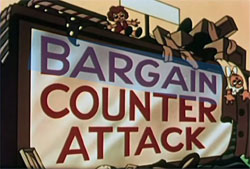 We begin with a brief honorable mention for Bargain Counter Attack (Paramount/Famous, Little Lulu, 1/11/46 – I Sparber, dir.) Lulu has received a dolly as a gift she is dissatisfied with, and brings it back to the department store where it was purchased for an exchange slip. The only problem is, what to exchange it for? Lulu tries out nearly everything in the store, wreaking havoc with each item, only to reach the same conclusion each time she is through with the tryout – “It’s not what I want, mister.” The floorwalker takes it in the chin time and again from her antics, ranging from public humiliation in a baby carriage to being clothed in a simulated suit of armor by silverware and bowls Lulu has upset. Things get critical when Lulu starts using a vacuum cleaner as a substitute for a fishing pole in an indoor goldfish pond on the main sales floor. The floorwalker seizes the vacuum nozzle from her and tosses it in the pond, then takes off after Lulu at full speed – never realizing that he has left the vacuum running, taking on all the water from the pond. Lulu heads for the toy department, and is seen sliding down a kiddie slide while riding in the cockpit of a kiddie-car sized plane. The plane is launched from the end of the slide and flies out over the center rotunda of the store, but the floorwalker is able to lean over an upper railing and grab the plane out from under Lulu by its wing. Lulu comes prepared, and has packed an umbrella to parachute down to the main floor, in graceful fashion that would make P.L. Travers proud. The floorwalker, however, is one step ahead of her, and waits on the ground floor below, with a large stick in hand to administer some corporal punishment. A rubbery nudge from behind him, however, shifts his attention away from Lulu, A look on the floorwalker’s face and a pinch of the object behind him give us the message that he believes he is being nudged by a plump female customer. He turns to extend a greeting, only to find himself staring into the bulging vacuum bag, which explodes, flooding the entire store. As the floorwalker knocks fish out of the canals of both of his ears, Lulu sails by on a canoe from sporting goods, announcing that she hopes she hasn’t caused him too much trouble, but she’s decided to keep her dolly after all. She returns the exchange slip, spindling it on one prong of the floorwalker’s handlebar moustache, then departs. There is no reaction for a beat – then, the floorwalker cracks, and, bellowing manic screams, he hops around in the water like a salmon swimming upstream, for the iris out.
We begin with a brief honorable mention for Bargain Counter Attack (Paramount/Famous, Little Lulu, 1/11/46 – I Sparber, dir.) Lulu has received a dolly as a gift she is dissatisfied with, and brings it back to the department store where it was purchased for an exchange slip. The only problem is, what to exchange it for? Lulu tries out nearly everything in the store, wreaking havoc with each item, only to reach the same conclusion each time she is through with the tryout – “It’s not what I want, mister.” The floorwalker takes it in the chin time and again from her antics, ranging from public humiliation in a baby carriage to being clothed in a simulated suit of armor by silverware and bowls Lulu has upset. Things get critical when Lulu starts using a vacuum cleaner as a substitute for a fishing pole in an indoor goldfish pond on the main sales floor. The floorwalker seizes the vacuum nozzle from her and tosses it in the pond, then takes off after Lulu at full speed – never realizing that he has left the vacuum running, taking on all the water from the pond. Lulu heads for the toy department, and is seen sliding down a kiddie slide while riding in the cockpit of a kiddie-car sized plane. The plane is launched from the end of the slide and flies out over the center rotunda of the store, but the floorwalker is able to lean over an upper railing and grab the plane out from under Lulu by its wing. Lulu comes prepared, and has packed an umbrella to parachute down to the main floor, in graceful fashion that would make P.L. Travers proud. The floorwalker, however, is one step ahead of her, and waits on the ground floor below, with a large stick in hand to administer some corporal punishment. A rubbery nudge from behind him, however, shifts his attention away from Lulu, A look on the floorwalker’s face and a pinch of the object behind him give us the message that he believes he is being nudged by a plump female customer. He turns to extend a greeting, only to find himself staring into the bulging vacuum bag, which explodes, flooding the entire store. As the floorwalker knocks fish out of the canals of both of his ears, Lulu sails by on a canoe from sporting goods, announcing that she hopes she hasn’t caused him too much trouble, but she’s decided to keep her dolly after all. She returns the exchange slip, spindling it on one prong of the floorwalker’s handlebar moustache, then departs. There is no reaction for a beat – then, the floorwalker cracks, and, bellowing manic screams, he hops around in the water like a salmon swimming upstream, for the iris out.
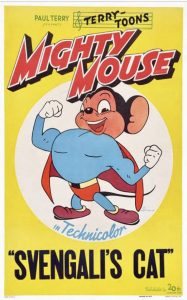 Svengali’s Cat (Terrytoons/Fox, Mighty Mouse, 1/18/46 – Eddie Donnelly, dir.) – Updating on the classic tale of the cat’s owner, a gypsy-accented cat has a master plan to place whole communities of male mice into captivity for the cats, by the use of hypnosis – and the hypnotically-attractive singing of a female mouse captured and placed into a trance to assist in the plan, providing the cat with his own “Trilby” to match his master’s past endeavors. The hypnotized mouse is dolled-up in blue gown, blonde wig, and lipstick, and commanded to sing “Ben Bolt” (a return to a plot point previously used in the early Oil Can Harry/Fannie Zilch episode “Hypnotic Eyes” during the early 1930’s). A squad of police bulldogs are hot on the trail of the mice disappearances, and one of them observes an audience of mice surrounding the singing female, who suddenly disappear through a trap door into a basement, Inside, the Svengali cat and his feline henchmen await to herd the mice into traps with whips. The observant bulldog calls for the rest of the cops with a police whistle, and an unseen battle ensues inside the building with the cats. However, Svengali cat gets the upper hand, and hypnotizes the dogs, commanding them to take a “long journey”. Fueled solely by Svengali’s will power, the pot-bellied dojs rise and lightly float out the chimney, helplessly rising into space, and pass the moon, where they arouse the attention of Mighty Mouse. Oddly, Mighty never rescues the dogs, but streaks Earthward to help the mice.
Svengali’s Cat (Terrytoons/Fox, Mighty Mouse, 1/18/46 – Eddie Donnelly, dir.) – Updating on the classic tale of the cat’s owner, a gypsy-accented cat has a master plan to place whole communities of male mice into captivity for the cats, by the use of hypnosis – and the hypnotically-attractive singing of a female mouse captured and placed into a trance to assist in the plan, providing the cat with his own “Trilby” to match his master’s past endeavors. The hypnotized mouse is dolled-up in blue gown, blonde wig, and lipstick, and commanded to sing “Ben Bolt” (a return to a plot point previously used in the early Oil Can Harry/Fannie Zilch episode “Hypnotic Eyes” during the early 1930’s). A squad of police bulldogs are hot on the trail of the mice disappearances, and one of them observes an audience of mice surrounding the singing female, who suddenly disappear through a trap door into a basement, Inside, the Svengali cat and his feline henchmen await to herd the mice into traps with whips. The observant bulldog calls for the rest of the cops with a police whistle, and an unseen battle ensues inside the building with the cats. However, Svengali cat gets the upper hand, and hypnotizes the dogs, commanding them to take a “long journey”. Fueled solely by Svengali’s will power, the pot-bellied dojs rise and lightly float out the chimney, helplessly rising into space, and pass the moon, where they arouse the attention of Mighty Mouse. Oddly, Mighty never rescues the dogs, but streaks Earthward to help the mice.
 For no apparent reason, Svengali’s goon squad come equipped with their own air force of single-engine fighter planes, ever at the ready to do battle with any attacker from the air. Mighty’s approach sends them into the skies, but before takeoff, Svengali decides to eliminate the evidence, by seating the hypnotized female mouse on a log headed for a buzz saw. High above the Earth, Mighty and the cats engage in a real “dogfight”, falling back on the old gag of having the planes develop canine faces and bark, whine, and whimper like real dogs in purely toony fashion. It is, at least, one of the more vividly-animated uses of the gag, utilizing real dog barking for sound effects, and staying with the metaphor longer than any other previous cartoon. Mighty engages in fisticuffs with one plane’s boxing wheels, grabs hold of a second plane by the tail and gives if a spin-around in a wrestling hold so that in collides with plane one, then goes head to head with Svengali’s plane, grabbing the propeller to spin the plane in a clockwise whirl, throwing Svengali from the cockpit (presumably to his doom, as he is never seen again). Just to clean up the skies, once the propeller snaps off, the third plane explodes, eliminating need for further aerial animation. But there’s still the matter of the rescue of the sweet young thing, who, still singing and in a stiff seated position, has toppled over on her back while riding the log, her blonde-wigged head aimed straight for the teeth of the buzz saw. A supersonic dive by Mighty, and rescue is achieved before the saw can sever a single lock of hair from the wig. Resting the damsel on the ground, Mighty proves he knows a hypnotic trick or two himself, mesmerizing the girl into standing position, bringing her singing to an abrupt halt, then breaking the spell. Opening her eyes, she responds, “Mighty Mouse. My hero”, and smothers him with a dozen kisses. The lipstick marks from Svengali’s freshly-applied lipstick appear all over Mighty’s face, as he heaves a contented sigh for the fade out.
For no apparent reason, Svengali’s goon squad come equipped with their own air force of single-engine fighter planes, ever at the ready to do battle with any attacker from the air. Mighty’s approach sends them into the skies, but before takeoff, Svengali decides to eliminate the evidence, by seating the hypnotized female mouse on a log headed for a buzz saw. High above the Earth, Mighty and the cats engage in a real “dogfight”, falling back on the old gag of having the planes develop canine faces and bark, whine, and whimper like real dogs in purely toony fashion. It is, at least, one of the more vividly-animated uses of the gag, utilizing real dog barking for sound effects, and staying with the metaphor longer than any other previous cartoon. Mighty engages in fisticuffs with one plane’s boxing wheels, grabs hold of a second plane by the tail and gives if a spin-around in a wrestling hold so that in collides with plane one, then goes head to head with Svengali’s plane, grabbing the propeller to spin the plane in a clockwise whirl, throwing Svengali from the cockpit (presumably to his doom, as he is never seen again). Just to clean up the skies, once the propeller snaps off, the third plane explodes, eliminating need for further aerial animation. But there’s still the matter of the rescue of the sweet young thing, who, still singing and in a stiff seated position, has toppled over on her back while riding the log, her blonde-wigged head aimed straight for the teeth of the buzz saw. A supersonic dive by Mighty, and rescue is achieved before the saw can sever a single lock of hair from the wig. Resting the damsel on the ground, Mighty proves he knows a hypnotic trick or two himself, mesmerizing the girl into standing position, bringing her singing to an abrupt halt, then breaking the spell. Opening her eyes, she responds, “Mighty Mouse. My hero”, and smothers him with a dozen kisses. The lipstick marks from Svengali’s freshly-applied lipstick appear all over Mighty’s face, as he heaves a contented sigh for the fade out.
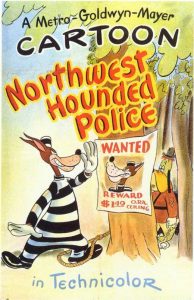 Northwest Hounded Police (MGM (Droopy), 8/3/46 – Tex Avery, dir.) – Essentially the sequel to the original Droopy episode, “Dumb-Hounded”, this film gives Droopy the chance to chase once again Avery’s wolf in convict stripes, newly escaped from Alka-Fizz prison. Renamed as Sgt. McPoodle of the Mounted Police (one of at least two times where Droopy was identified as a poodle, though drawn as a basset hound), Droopy pursues the wolf (who he refers to as “Joe”) through the wilds of Canada and beyond, as usual always appearing one step ahead of the wolf at every turn. Encountering a highway, the wolf hails a taxi randomly travelling through the snow-covered back country, and directs, “To the airport.” Ignoring his convict stripes and the chance of becoming accessory to an escape, the driver, as seen from a geographic map view, is apparently unaware of the existence of any air field for at least 2,000 miles, transporting the wolf from Northern Canada across the border into the U.S. (making am outward turn to avoid the lettering of the names of Canada and the U.S. on the map), to somewhere in the vicinity of California, where he finally arrives at Wright and Wrong Field. The wolf reaches into his pocket to pay the fare – then finds his driver has been Droopy all along. The wolf performs one of nearly two dozen extreme shock takes in this picture (each one wilder than the next), and races for a plane, taking off as pilot in control. The plane, a silver four-engine passenger job, resembles a Douglas DC-4, a frequent favorite of airlines of the day.
Northwest Hounded Police (MGM (Droopy), 8/3/46 – Tex Avery, dir.) – Essentially the sequel to the original Droopy episode, “Dumb-Hounded”, this film gives Droopy the chance to chase once again Avery’s wolf in convict stripes, newly escaped from Alka-Fizz prison. Renamed as Sgt. McPoodle of the Mounted Police (one of at least two times where Droopy was identified as a poodle, though drawn as a basset hound), Droopy pursues the wolf (who he refers to as “Joe”) through the wilds of Canada and beyond, as usual always appearing one step ahead of the wolf at every turn. Encountering a highway, the wolf hails a taxi randomly travelling through the snow-covered back country, and directs, “To the airport.” Ignoring his convict stripes and the chance of becoming accessory to an escape, the driver, as seen from a geographic map view, is apparently unaware of the existence of any air field for at least 2,000 miles, transporting the wolf from Northern Canada across the border into the U.S. (making am outward turn to avoid the lettering of the names of Canada and the U.S. on the map), to somewhere in the vicinity of California, where he finally arrives at Wright and Wrong Field. The wolf reaches into his pocket to pay the fare – then finds his driver has been Droopy all along. The wolf performs one of nearly two dozen extreme shock takes in this picture (each one wilder than the next), and races for a plane, taking off as pilot in control. The plane, a silver four-engine passenger job, resembles a Douglas DC-4, a frequent favorite of airlines of the day.
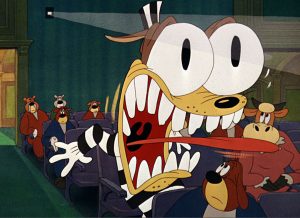 At an insanely-complicated control panel (featuring approximately 75 gauges with indicator pointers wildly spinning in clockwise and counter-clockwise directions), the wolf flies with confidence – until a voice is heard on the Intercom from a seat behind him. “Pilot to co-pilot. BOO!” It’s Droopy (who else?). His choice of words is interesting, indicating that, although the wolf is clearly in the pilot’s seat, Droopy views himself as the one who really has the ship under control. Another mad shock take, and the wolf dives out the window, fortunately wearing a parachute. He pulls a ripcord, but instead of silk receives only Droopy at the other end of the line, keeping them both aloft with the use of a small umbrella. He lets go of the lines supporting the wolf, and wishes him, “Happy landings.” The wolf falls, encountering a small barren atoll in the sea. A middle-sized boulder rests nearby where he lands, and the wolf confides to the audience, “Yeah, I know. He’ll probably be right under that rock.” Instead, Droopy appears under a small pebble on the wolf’s opposite side, responding, “Nope. Under this one.” The crazed wolf begins beating himself on the head with the larger stone, whimpering “No, not that!” After numerous more outlandish twists beyond the scope of this article, the film one-ups its predecessor episode, as the wolf makes a wrong turn in a hotel corridor, entering a door which magically transforms into a cell door as soon as it is closed, with Droopy turning the key. From behind bars, the wolf mutters, “Well, I’ll be. He finally got me. But there’s just one thing that’s botherin’ me. I wonder if there could have been more than one of them little guys.” Finally revealing Droopy’s secret, and improving upon a closing first used in Bugs Bunny’s “Tortoise Beats Hare”, the camera pans to a corridor packed with, at best count, 224 Droopy’s, who respond in unison, “What do you think, brother?”
At an insanely-complicated control panel (featuring approximately 75 gauges with indicator pointers wildly spinning in clockwise and counter-clockwise directions), the wolf flies with confidence – until a voice is heard on the Intercom from a seat behind him. “Pilot to co-pilot. BOO!” It’s Droopy (who else?). His choice of words is interesting, indicating that, although the wolf is clearly in the pilot’s seat, Droopy views himself as the one who really has the ship under control. Another mad shock take, and the wolf dives out the window, fortunately wearing a parachute. He pulls a ripcord, but instead of silk receives only Droopy at the other end of the line, keeping them both aloft with the use of a small umbrella. He lets go of the lines supporting the wolf, and wishes him, “Happy landings.” The wolf falls, encountering a small barren atoll in the sea. A middle-sized boulder rests nearby where he lands, and the wolf confides to the audience, “Yeah, I know. He’ll probably be right under that rock.” Instead, Droopy appears under a small pebble on the wolf’s opposite side, responding, “Nope. Under this one.” The crazed wolf begins beating himself on the head with the larger stone, whimpering “No, not that!” After numerous more outlandish twists beyond the scope of this article, the film one-ups its predecessor episode, as the wolf makes a wrong turn in a hotel corridor, entering a door which magically transforms into a cell door as soon as it is closed, with Droopy turning the key. From behind bars, the wolf mutters, “Well, I’ll be. He finally got me. But there’s just one thing that’s botherin’ me. I wonder if there could have been more than one of them little guys.” Finally revealing Droopy’s secret, and improving upon a closing first used in Bugs Bunny’s “Tortoise Beats Hare”, the camera pans to a corridor packed with, at best count, 224 Droopy’s, who respond in unison, “What do you think, brother?”
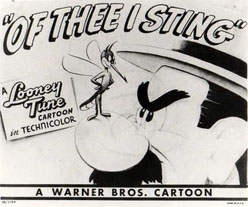 Of Thee I Sting (Warner, 8/17/46 – I. (Friz) Freleng, dir.) – As discussed last time, although the war was over, Freleng decided the motto of “waste not, want not” should be observed, and that civilian audiences should get a savoring of his brilliant insect “mockumentary” on strategic military preparation for a mosquito attack, in the same manner as the Army’s “Target Snafu”. This time, the mosquitos have lined up as target for tonight not a bare-butt Snafu in an army camp, but a fat owner of a rustic bed and board called the “Shady Rest” (not necessarily from Hooterville or a certain junction), who is formidably prepared with anti-aircraft (a Flit gun), poison gas (DDT), heavy artillery (a fly swatter), and a steel fortress (protective screening). Many principal sequences of the Snafu original are reused in newly color-painted form, or presented with only slight modification. Removed are the references to malaria, these skeeters now being on the turf of the good old U.S.A., so the rejected inductees are merely goofy looking weaklings rather than those not carrying the malaria germ. The “manual of arms” presentation of nose stingers for inspection gets an extra gag, by one mosquito presenting a stinger that springs out a half a dozen handy-dandy tools like a Swiss army knife. Classes at “ground school” are depicted, consisting of a hole in the ground with a drawing in the shape of a schoolhouse around it, where graphs of the man’s portly physique are studied by eager students. The cadets test for gas attack readiness by volunteers practicing endurance under a glass lid covering slices of Limburger cheese. The flypaper obstacle course in conquered by some advance planning, with one mosquito wearing pair upon pair of army boots which he leaves behind with each step, giving him just enough strides to cross the sticky surface before his bare feet are exposed. Aircraft carrier flying is practiced atop a floating can of sardines instead of a flat leaf, with a quick landing ensured by catching the incoming flyer on flypaper. The cadets win their wings – literally – by having them physically attached by a superior officer. The big strategy meeting of the generals takes place inside an empty tin of Log Cabin syrup, where the last reconnaissance photo depicts the man’s seat of his pants instead of his nude butt. The final raid has advance troops sneak up on the structure by disguising themselves with daisy petals. Additional troops are transported in via a landing craft consisting of the framework of a carpet sweeper minus its long handle. The troops scale the protective screening, and use their stingers as hacksaws to cut a hole for the fliers to dive through. The usual “YEOWW!” is achieved from the human victim. The new final shot has the fliers returning to the flat top. However, the deck signaler who is supposed to give them the “cut” to land sends all of the fliers on a misdirected course, crashing them into the water. He then turns to face the camera, revealing that he is cross-eyed, and shrugs in confusion for the iris out.
Of Thee I Sting (Warner, 8/17/46 – I. (Friz) Freleng, dir.) – As discussed last time, although the war was over, Freleng decided the motto of “waste not, want not” should be observed, and that civilian audiences should get a savoring of his brilliant insect “mockumentary” on strategic military preparation for a mosquito attack, in the same manner as the Army’s “Target Snafu”. This time, the mosquitos have lined up as target for tonight not a bare-butt Snafu in an army camp, but a fat owner of a rustic bed and board called the “Shady Rest” (not necessarily from Hooterville or a certain junction), who is formidably prepared with anti-aircraft (a Flit gun), poison gas (DDT), heavy artillery (a fly swatter), and a steel fortress (protective screening). Many principal sequences of the Snafu original are reused in newly color-painted form, or presented with only slight modification. Removed are the references to malaria, these skeeters now being on the turf of the good old U.S.A., so the rejected inductees are merely goofy looking weaklings rather than those not carrying the malaria germ. The “manual of arms” presentation of nose stingers for inspection gets an extra gag, by one mosquito presenting a stinger that springs out a half a dozen handy-dandy tools like a Swiss army knife. Classes at “ground school” are depicted, consisting of a hole in the ground with a drawing in the shape of a schoolhouse around it, where graphs of the man’s portly physique are studied by eager students. The cadets test for gas attack readiness by volunteers practicing endurance under a glass lid covering slices of Limburger cheese. The flypaper obstacle course in conquered by some advance planning, with one mosquito wearing pair upon pair of army boots which he leaves behind with each step, giving him just enough strides to cross the sticky surface before his bare feet are exposed. Aircraft carrier flying is practiced atop a floating can of sardines instead of a flat leaf, with a quick landing ensured by catching the incoming flyer on flypaper. The cadets win their wings – literally – by having them physically attached by a superior officer. The big strategy meeting of the generals takes place inside an empty tin of Log Cabin syrup, where the last reconnaissance photo depicts the man’s seat of his pants instead of his nude butt. The final raid has advance troops sneak up on the structure by disguising themselves with daisy petals. Additional troops are transported in via a landing craft consisting of the framework of a carpet sweeper minus its long handle. The troops scale the protective screening, and use their stingers as hacksaws to cut a hole for the fliers to dive through. The usual “YEOWW!” is achieved from the human victim. The new final shot has the fliers returning to the flat top. However, the deck signaler who is supposed to give them the “cut” to land sends all of the fliers on a misdirected course, crashing them into the water. He then turns to face the camera, revealing that he is cross-eyed, and shrugs in confusion for the iris out.
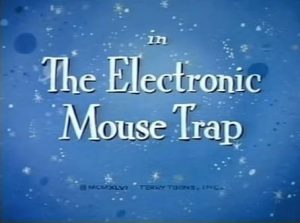 The Electronic Mouse Trap (Terrytoons/Fox, Mighty Mouse, 9/6/46 – Mannie Davis, dir.) – The introductory scenes of this film qualify it for honorable mention, presenting a potpourri of revolutionary inventions in the post-war world. In the field of transportation, a bright red car plunges over a seaside cliff, pulling in its wheels and changing the shape of its body to become a speedboat, then sprouting feathered wings to fly away like a cross between a bird and an airplane. The flying cement mixer sequence from the finale of “My Boy Johnny” is also reused, pouring out a skyscraper with a concrete swirl and a cherry on top. But the film’s principal invention goes in an entirely different direction – a mechanical mouse-catcher, looking like a cross between a robot dinosaur and a steam shovel, which hypnotizes mice with an electronic ray, then sucks them up like a giant vacuum, to box them in egg crates for easy transportation on an assembly line within its chassis. The thing also spits fire, and can shoot atomic bombs! Mighty Mouse has his hands full, but as usual survives the machine’s attack unmarked, needing only to dust himself off with a whisk broom after being exposed to the mushroom cloud, leaving the narrator to make his usual comment – “What a mouse. WHAT A MOUSE!”
The Electronic Mouse Trap (Terrytoons/Fox, Mighty Mouse, 9/6/46 – Mannie Davis, dir.) – The introductory scenes of this film qualify it for honorable mention, presenting a potpourri of revolutionary inventions in the post-war world. In the field of transportation, a bright red car plunges over a seaside cliff, pulling in its wheels and changing the shape of its body to become a speedboat, then sprouting feathered wings to fly away like a cross between a bird and an airplane. The flying cement mixer sequence from the finale of “My Boy Johnny” is also reused, pouring out a skyscraper with a concrete swirl and a cherry on top. But the film’s principal invention goes in an entirely different direction – a mechanical mouse-catcher, looking like a cross between a robot dinosaur and a steam shovel, which hypnotizes mice with an electronic ray, then sucks them up like a giant vacuum, to box them in egg crates for easy transportation on an assembly line within its chassis. The thing also spits fire, and can shoot atomic bombs! Mighty Mouse has his hands full, but as usual survives the machine’s attack unmarked, needing only to dust himself off with a whisk broom after being exposed to the mushroom cloud, leaving the narrator to make his usual comment – “What a mouse. WHAT A MOUSE!”
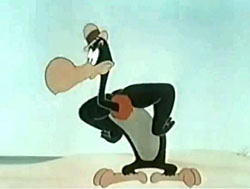 Uncultured Vulture (Columbia/Screen Gems, Phantasy (Cinecolor), 2/6/47 – Bob Wickersham, dir,), has been discussed in past articles, and is a weak attempt to copy the themes of Tex Avery’s “What’s Buzzin’ Buzzard”, between an explorer/professor who has been lost for 10 years, and the buzzard who has pursued him, waiting for him to “kick the bucket” (which the professor literally does, kicking it onto the buzzard’s head). The desert island on which the action takes place is so barren, however, that it is impossible to feel there are enough idea present to have kept the chase going for 10 years – or enough food to have sustained them all this time. By the end of the film, the vulture has the professor simmering in a pot, with ropes tied around his neck to prevent him from climbing out. However, the sound of a motor is heard overhead, and a large dirigible marked “Searching Party” descends toward the island. The professor gloats that now he will be rescued, despite the vulture’s plans to eat him. The surprise comes when the passengers disembark from the dirigible – all vultures, who were searching for their comrade all these years. Spotting the cooking pot, they all ask “Dinner ready?” All the professor can do is shrug his shoulders at the hopelessness of the situation, grab a salt shaker from nowhere, and begin seasoning himself with it, as the scene irises out.
Uncultured Vulture (Columbia/Screen Gems, Phantasy (Cinecolor), 2/6/47 – Bob Wickersham, dir,), has been discussed in past articles, and is a weak attempt to copy the themes of Tex Avery’s “What’s Buzzin’ Buzzard”, between an explorer/professor who has been lost for 10 years, and the buzzard who has pursued him, waiting for him to “kick the bucket” (which the professor literally does, kicking it onto the buzzard’s head). The desert island on which the action takes place is so barren, however, that it is impossible to feel there are enough idea present to have kept the chase going for 10 years – or enough food to have sustained them all this time. By the end of the film, the vulture has the professor simmering in a pot, with ropes tied around his neck to prevent him from climbing out. However, the sound of a motor is heard overhead, and a large dirigible marked “Searching Party” descends toward the island. The professor gloats that now he will be rescued, despite the vulture’s plans to eat him. The surprise comes when the passengers disembark from the dirigible – all vultures, who were searching for their comrade all these years. Spotting the cooking pot, they all ask “Dinner ready?” All the professor can do is shrug his shoulders at the hopelessness of the situation, grab a salt shaker from nowhere, and begin seasoning himself with it, as the scene irises out.
 Mail Dog (Disney/RKO, Pluto, 11/13.47 – Charles Nichols, dir.) – Mail plane 51 is having trouble getting through a rocky mountain pass in the height of winter. Ice is forming on the wigs, and the pilot turns back. He is instructed to drop his mail sack by parachute at Outpost No. 5, where it will be carried through to Quagmire Airport by dog sled. Such dog is Pluto, who receives the mail drop by way of a slap in the face from the descending pouch. Pluto rigs up a sled, but can’t seem to stay ahead of it on a downward slope. The sled gets underfoot, sweeping Pluto away and into a snowbank. When Pluto emerges from the white stuff, he finds the mail pouch has tumbled out, and is resting in the open claws of a carved figure on an Indian totem pole. Pluto challenges the ferocious looking face, but his challenge is met by the echo of his own bark within the hollow totem. He runs in panic, his neck inside the loop of the pouch strap, finally pulling the mail pouch free. Pluto proceeds ahead with more caution.
Mail Dog (Disney/RKO, Pluto, 11/13.47 – Charles Nichols, dir.) – Mail plane 51 is having trouble getting through a rocky mountain pass in the height of winter. Ice is forming on the wigs, and the pilot turns back. He is instructed to drop his mail sack by parachute at Outpost No. 5, where it will be carried through to Quagmire Airport by dog sled. Such dog is Pluto, who receives the mail drop by way of a slap in the face from the descending pouch. Pluto rigs up a sled, but can’t seem to stay ahead of it on a downward slope. The sled gets underfoot, sweeping Pluto away and into a snowbank. When Pluto emerges from the white stuff, he finds the mail pouch has tumbled out, and is resting in the open claws of a carved figure on an Indian totem pole. Pluto challenges the ferocious looking face, but his challenge is met by the echo of his own bark within the hollow totem. He runs in panic, his neck inside the loop of the pouch strap, finally pulling the mail pouch free. Pluto proceeds ahead with more caution.
A jack rabbit with huge feet is freezing and blue with cold, pacing the snow and blowing on his hands to try to keep warm. Pluto playfully puts a scare into him with a loud bark. But when the hare looks back to see what the danger was, all he sees is Pluto’s belly – transformed in his imagination into the warmth of a pot-bellied stove. The rabbit is no longer afraid, and sidles up to Pluto, briefly warming himself to a warm brown, while Pluto is turned blue by the absorbed cold from the hare’s body. Pluto tries to chase the rabbit away – but the rabbit gets another idea, and doubles back for the warmth of the protective blanket covering the mail pouch on the sled. Concealed under it, he remains unseen by Pluto upon his return. Pluto lies down in frustration upon the blanket, not noticing the hare’s long feet protruding from underneath, which take on the movements and gestures of two additional front paws below Pluto’s person, offering Pluto a shrugging gesture as he looks at the camera as if to say, “I don’t know”. Pluto tests out the situation by sniffing at his own front paws, then at the rabbit’s feet – wincing from the unfamiliar smell. The secret is out, and the rabbit takes off, accidentally snagging the mail pouch around his neck. The chase develops into a wild ride as the sled once again overtakes Pluto, also sweeping up the rabbit, for a careening toboggan ride through the mountain passes, finally coming to a stop at the very airfield Pluto was bound for. As the sled abruptly halts in a snowbank, the mail pouch flies off the rabbit’s neck – right into the hands of a waiting pilot, who thanks them for a speedy delivery. The plane takes off (in what appears to be reused animation from “Pluto and the Armadillo”), and Pluto makes friends with the rabbit, offering him a cozy tide home under the sled’s blanket, for the iris out.
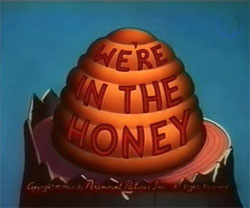 We’re In the Honey – (Paramount/Famous, Noveltoon, 3/19/48 – Seymour Kneitel, dir.) – Life inside a beehive is explored, where things are “humming” as usual according to the queen bee (who bears conspicuous facial resemblance to Lois Lane from the studio’s abandoned Superman cartoons). A bulletin is received regarding a neighboring bee community which is on the verge of ruin, their hive having been raided and ransacked by a marauding bear. They face starvation, and the queen bee orders her subjects to gather as much honey as they can for a rescue mission to their less-fortunate neighbors. In an original production number, “This Can Be a Sweeter World”, the honey gathering and storage takes place, until along comes the same rampaging bear, in search of another meal. An observant bee notes his presence while pulling down window shades inside the hive, grabbing hold of the eyelid of the bear’s peeping eye by mistake. He sounds a bugle call, rallying the worker bees to “fix bayonets”, as they install their stingers. The bear’s paws and nose take some liberal puncturing, but he retaliates with a smoke attack from a pipe he seems to have borrowed from Popeye. The heroic bee leader disconnects the tobacco bowl from the stem, then carves with a small lawn mower a target for tonight on the bear’s behind, while the swarm form into the shape of a bow and arrow for a direct hit. The bear is routed, and the hero bee receives a kiss from the queen that makes his red hair appear to be on fire. The swarm sets off, buckets of honey in hand, on their mission, forming into the shape of a mighty plane with a healing cross insignia on its side, for the iris out.
We’re In the Honey – (Paramount/Famous, Noveltoon, 3/19/48 – Seymour Kneitel, dir.) – Life inside a beehive is explored, where things are “humming” as usual according to the queen bee (who bears conspicuous facial resemblance to Lois Lane from the studio’s abandoned Superman cartoons). A bulletin is received regarding a neighboring bee community which is on the verge of ruin, their hive having been raided and ransacked by a marauding bear. They face starvation, and the queen bee orders her subjects to gather as much honey as they can for a rescue mission to their less-fortunate neighbors. In an original production number, “This Can Be a Sweeter World”, the honey gathering and storage takes place, until along comes the same rampaging bear, in search of another meal. An observant bee notes his presence while pulling down window shades inside the hive, grabbing hold of the eyelid of the bear’s peeping eye by mistake. He sounds a bugle call, rallying the worker bees to “fix bayonets”, as they install their stingers. The bear’s paws and nose take some liberal puncturing, but he retaliates with a smoke attack from a pipe he seems to have borrowed from Popeye. The heroic bee leader disconnects the tobacco bowl from the stem, then carves with a small lawn mower a target for tonight on the bear’s behind, while the swarm form into the shape of a bow and arrow for a direct hit. The bear is routed, and the hero bee receives a kiss from the queen that makes his red hair appear to be on fire. The swarm sets off, buckets of honey in hand, on their mission, forming into the shape of a mighty plane with a healing cross insignia on its side, for the iris out.
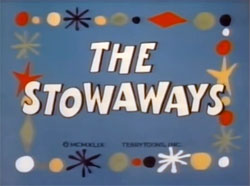 The Stowaways (Terrytoons/Fox, Heckle and Jeckle, 4/1/49 – Connie Rasinski, dir.) – Previously visited during our vacation articles of a while ago, this episode plays more broadly upon the term “airship” than any other film – transforming a trans-continental China Clipper into the closest possible equivalent of an ocean liner in the air. Our devious magpie duo have eyes for an air trip to Africa, vividly depicted on a billboard outside a docking station for the massive flying boat. The six-engine plane might be the prototype for Howard Hughes’ “Spruce Goose” in dimensions – so tall, it needs a motorized escalator for a gangplank for passenger boarding. Heckle daydreams on the way up: “I can see us now. Surrounded by native dancers. They’re throwing a big party for us. We’re the center of attraction.” Confronted at the top by a tough bulldog in full nautical uniform, Heckle claims they’re friends of the captain. “Well I’m the captain!” replies the dog. “Beat it!” He gives both birds the boot, landing them in a heap on the dock, where a gasoline truck is pumping engine fuel through a long hose. Ignoring all hazards of fumes, flammability, and suffocation, the birds jump into the tanker truck and are sucked upwards into the engine, emerging with a crash through the instruments of the plane’s control panel into the cockpit. For all their effort, the captain is again right on the spot to see them emerge, and throws them out the cockpit window into the ocean. ”Leave it to you to pick the hard way”, says Heckle. Stretching plausibility even further, the birds prove third time’s a charm, with the use of a borrowed motorboat. Jeckle stands atop the rotating starter of the outboard motor, carrying two oars. Heckle gives the starter rope a pull, whirling Jeckle’s oars as helicopter blades, propelling the boat into the air. They intercept the seaplane, which for no apparent reason has left a belly-hatch open in flight, with a rope ladder extending outside to boot. The magpies grab the ladder, abandon the boat, and are in.
The Stowaways (Terrytoons/Fox, Heckle and Jeckle, 4/1/49 – Connie Rasinski, dir.) – Previously visited during our vacation articles of a while ago, this episode plays more broadly upon the term “airship” than any other film – transforming a trans-continental China Clipper into the closest possible equivalent of an ocean liner in the air. Our devious magpie duo have eyes for an air trip to Africa, vividly depicted on a billboard outside a docking station for the massive flying boat. The six-engine plane might be the prototype for Howard Hughes’ “Spruce Goose” in dimensions – so tall, it needs a motorized escalator for a gangplank for passenger boarding. Heckle daydreams on the way up: “I can see us now. Surrounded by native dancers. They’re throwing a big party for us. We’re the center of attraction.” Confronted at the top by a tough bulldog in full nautical uniform, Heckle claims they’re friends of the captain. “Well I’m the captain!” replies the dog. “Beat it!” He gives both birds the boot, landing them in a heap on the dock, where a gasoline truck is pumping engine fuel through a long hose. Ignoring all hazards of fumes, flammability, and suffocation, the birds jump into the tanker truck and are sucked upwards into the engine, emerging with a crash through the instruments of the plane’s control panel into the cockpit. For all their effort, the captain is again right on the spot to see them emerge, and throws them out the cockpit window into the ocean. ”Leave it to you to pick the hard way”, says Heckle. Stretching plausibility even further, the birds prove third time’s a charm, with the use of a borrowed motorboat. Jeckle stands atop the rotating starter of the outboard motor, carrying two oars. Heckle gives the starter rope a pull, whirling Jeckle’s oars as helicopter blades, propelling the boat into the air. They intercept the seaplane, which for no apparent reason has left a belly-hatch open in flight, with a rope ladder extending outside to boot. The magpies grab the ladder, abandon the boat, and are in.
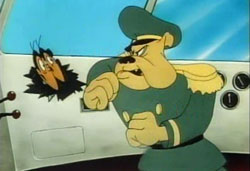 Inside, they find a deserted grand banquet hall, with a wall of portholes as its background decor. As chef Dimwit attempts to serve the Captain his dinner, the birds employ sleight of hand through the portholes, substituting a potted plant for the Captain’s turkey, sucking away his milk through a straw, etc. Each time the captain looks into a porthole, he gets socked by a mallet, boxing glove, and other items. The captain bursts outside, finding the magpies on a small ship-style observation deck (ignoring any need for a pressurized cabin.) Producing a pistol, the captain commands the birds to “walk the plank” off the side of the plane. Heckle pleads that he’s too young to die, while Jeckle climbs back underneath the plank, producing a saw. Heckle makes a quick dart between the captain’s legs, as Jeckle severs the plank in two. The captain falls, intercepting one of the planes’ giant tires (strange, as the plane took off from water), which acts as a slingshot to throw the captain upwards, through the deck planking of the plane’s flooring. Heckle and Jeckle race into the cockpit, and take the controls, alternating the ship from steep climbs to power dives, and sending the Captain into endless skids on deck. The Captain finally slides into the cockpit, crashing headfirst into the instrument panel.
Inside, they find a deserted grand banquet hall, with a wall of portholes as its background decor. As chef Dimwit attempts to serve the Captain his dinner, the birds employ sleight of hand through the portholes, substituting a potted plant for the Captain’s turkey, sucking away his milk through a straw, etc. Each time the captain looks into a porthole, he gets socked by a mallet, boxing glove, and other items. The captain bursts outside, finding the magpies on a small ship-style observation deck (ignoring any need for a pressurized cabin.) Producing a pistol, the captain commands the birds to “walk the plank” off the side of the plane. Heckle pleads that he’s too young to die, while Jeckle climbs back underneath the plank, producing a saw. Heckle makes a quick dart between the captain’s legs, as Jeckle severs the plank in two. The captain falls, intercepting one of the planes’ giant tires (strange, as the plane took off from water), which acts as a slingshot to throw the captain upwards, through the deck planking of the plane’s flooring. Heckle and Jeckle race into the cockpit, and take the controls, alternating the ship from steep climbs to power dives, and sending the Captain into endless skids on deck. The Captain finally slides into the cockpit, crashing headfirst into the instrument panel.
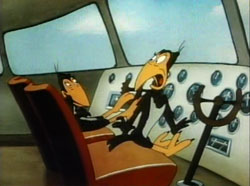 Finally, the Captain and Dimwit provide the birds with a peace offering, setting them up their own dinner table, and inviting them to be comfortably seated. “Well, this is more like it,” says Heckle. “And if you want a real surprise”, says the Captain, pointing to a button on the wall, “just press that buzzer.” Curiosity killed a cat, and the magpies can’t resist a push. A sign lights up above the button, reading “Hatch”. The same belly hatch they came in through opens below them like a bomb bay door, and the birds fall helplessly to Earth. (So why not flap your wings, guys?) They land directly into a large stewpot over a roaring fire, and discover themselves in the middle of a circle of dancing African cannibals. Jeckle recalls the prophetic words of Heckle, and repeats them while subjecting Heckle to repeated dunks into the stewpot water. “Ah, Africa! I can see us now. Surrounded by native dancers. We’re the center of attraction.”
Finally, the Captain and Dimwit provide the birds with a peace offering, setting them up their own dinner table, and inviting them to be comfortably seated. “Well, this is more like it,” says Heckle. “And if you want a real surprise”, says the Captain, pointing to a button on the wall, “just press that buzzer.” Curiosity killed a cat, and the magpies can’t resist a push. A sign lights up above the button, reading “Hatch”. The same belly hatch they came in through opens below them like a bomb bay door, and the birds fall helplessly to Earth. (So why not flap your wings, guys?) They land directly into a large stewpot over a roaring fire, and discover themselves in the middle of a circle of dancing African cannibals. Jeckle recalls the prophetic words of Heckle, and repeats them while subjecting Heckle to repeated dunks into the stewpot water. “Ah, Africa! I can see us now. Surrounded by native dancers. We’re the center of attraction.”
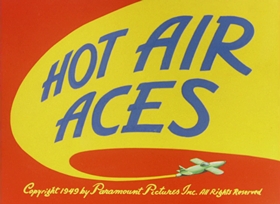 Hot Air Aces (Paramount/Famous, Popeye, 6/24/49 – I. Sparber, dir.) – Popeye and Bluto compete in a round the world air race (a secondary sign reading, “Last one home is a rotten egg”). Bluto claims rights as the “best man” who will win during the handshaking preliminaries, and hogs the camera for press publicity shots. As Popeye attempts to spin his prop for contact, Bluto gives him a hand, starting the prop spinning with Popeye still clinging on. Then, Bluto lights a fuse at the back of his sleek streamlined plane, igniting skyrockets for rocket-propelled speed. Olive helps the dizzy, unconscious Popeye back into the cockpit, and gets the plane started by pushing it down the runway like a car out of gas. She pushes the plane right off a cliff edge, nearly falling herself. Popeye regains consciousness only inches from a nose dive into the rocks below, and pulls up with so little leeway, his plane’s path mirrors the terrain of the rocky land below it. Meanwhile, Bluto is streaking through the skies like a comet. Popeye gives his propeller an added edge of speed by blowing gusts of air behind it with a fireplace bellows. Bluto kicks into second gear and passes the meddlesome runt, leaving Popeye’s engine sputtering for air in the smoky vapor trail left behind by Bluto’s engine.
Hot Air Aces (Paramount/Famous, Popeye, 6/24/49 – I. Sparber, dir.) – Popeye and Bluto compete in a round the world air race (a secondary sign reading, “Last one home is a rotten egg”). Bluto claims rights as the “best man” who will win during the handshaking preliminaries, and hogs the camera for press publicity shots. As Popeye attempts to spin his prop for contact, Bluto gives him a hand, starting the prop spinning with Popeye still clinging on. Then, Bluto lights a fuse at the back of his sleek streamlined plane, igniting skyrockets for rocket-propelled speed. Olive helps the dizzy, unconscious Popeye back into the cockpit, and gets the plane started by pushing it down the runway like a car out of gas. She pushes the plane right off a cliff edge, nearly falling herself. Popeye regains consciousness only inches from a nose dive into the rocks below, and pulls up with so little leeway, his plane’s path mirrors the terrain of the rocky land below it. Meanwhile, Bluto is streaking through the skies like a comet. Popeye gives his propeller an added edge of speed by blowing gusts of air behind it with a fireplace bellows. Bluto kicks into second gear and passes the meddlesome runt, leaving Popeye’s engine sputtering for air in the smoky vapor trail left behind by Bluto’s engine.
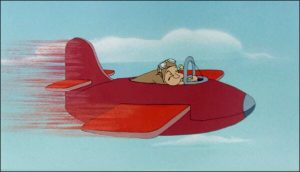 Bluto’s plane darts ahead to the first leg of the race route – Paris, France. While a Parisian attempts to woo a mademoiselle outside a café, Bluto’s plane muscles in, carrying the girl aloft to the top of the Eiffel Tower, where Bluto moors his plane with an anchor to engage in a little recreational romance of his own. (Amazing that for once, he shows an interest in any frail but Olive.) Back over the ocean, Popeye is still trying to catch up, adding propulsion in a manner any good sailor would understand – by breaking out a pair of oars. “Rub a dub dub, this crate’s just a tub”, Popeye chants. A thundercloud overhead emits a lightning bolt which saws off Popeye’s oars. Popeye nevertheless takes advantage of the change in the weather, by installing a lightning rod in the plane’s tail. When the next bolt hits, the plane yells “Woo Woo!” (Sounding exactly like Jack Mercer when he would sing the Popeye song without the aid of a pipe-toot sound effect), and races ahead at triple speed. Popeye passes Bluto on the tower, nearly pulling him over the railing. “That guy’s parlez-vous-ey is a lot of hooey”, quips Popeye, as he hops over the French Alps. He flies over the Mediterranean, zipping by the map of Italy so fast, he tears away part of the “boot”, leaving the Southern tip of the country with a bare foot. Popeye’s next sighted landmark is the Siberian Steppes – shaped like the steps of a staircase, with a Russian dancer performing upon each landing. Bluto finally catches up, lassoing the tail of Popeye’s plane with a rope. Popeye’s engine stalls and goes into sputters again. Bluto matches speed with Popeye’s plane from overhead, reaches down from his cockpit, and opens the hood of Popeye’s plane. “Your engine’s missing”, he declares, as he yanks the motor block out entirely, tossing it away. Popeye and his plane dizzily dive, smashing into an ocean reef, sending Popeye and the remains of the plane into the depths of the sea, parts strewn everywhere. The sailor lands inside a giant clam, but the creature doesn’t like his taste and spits him out – conveniently into a crate of spinach cans somehow left over from an undersea wreck. (That’s quality tin, as the cans amazingly haven’t rusted at all.) A passing swordfish helps the weakened Popeye by sawing off a can lid, and Popeye gets his meal. Forming his arms into the shape of a magnet, Popeye uses his bare energy to reassemble the plane parts perfectly – with one omission. “Wow, no pistons”, he observes, looking at empty cylinders in the motor block. Where there’s a will, there’s a way – and Popeye grabs ten more spinach cans, stuffing them in the cylinder holes as perfect fits. The spinach-powered engine mightily springs to life, and Popeye zooms out of the briny blue, leaving a shower of fish behind. He pulls ahead of Bluto, descending into place right ahead of Bluto’s nose. As Bluto accelerates for the kill, Popeye ignites a fiery blast from his supercharged engine – and reduces Bluto’s jet to a charred metal framework. Popeye streaks to the finish line, yet lands on a dime for a perfect stop over its edge. Olive greets him for an enthusiastic embrace, leaping into the cockpit – not observing that it is still full of sea water, and kissing a large fish that leaps out instead of Popeye, allowing Popeye to get a good laugh for the iris out.
Bluto’s plane darts ahead to the first leg of the race route – Paris, France. While a Parisian attempts to woo a mademoiselle outside a café, Bluto’s plane muscles in, carrying the girl aloft to the top of the Eiffel Tower, where Bluto moors his plane with an anchor to engage in a little recreational romance of his own. (Amazing that for once, he shows an interest in any frail but Olive.) Back over the ocean, Popeye is still trying to catch up, adding propulsion in a manner any good sailor would understand – by breaking out a pair of oars. “Rub a dub dub, this crate’s just a tub”, Popeye chants. A thundercloud overhead emits a lightning bolt which saws off Popeye’s oars. Popeye nevertheless takes advantage of the change in the weather, by installing a lightning rod in the plane’s tail. When the next bolt hits, the plane yells “Woo Woo!” (Sounding exactly like Jack Mercer when he would sing the Popeye song without the aid of a pipe-toot sound effect), and races ahead at triple speed. Popeye passes Bluto on the tower, nearly pulling him over the railing. “That guy’s parlez-vous-ey is a lot of hooey”, quips Popeye, as he hops over the French Alps. He flies over the Mediterranean, zipping by the map of Italy so fast, he tears away part of the “boot”, leaving the Southern tip of the country with a bare foot. Popeye’s next sighted landmark is the Siberian Steppes – shaped like the steps of a staircase, with a Russian dancer performing upon each landing. Bluto finally catches up, lassoing the tail of Popeye’s plane with a rope. Popeye’s engine stalls and goes into sputters again. Bluto matches speed with Popeye’s plane from overhead, reaches down from his cockpit, and opens the hood of Popeye’s plane. “Your engine’s missing”, he declares, as he yanks the motor block out entirely, tossing it away. Popeye and his plane dizzily dive, smashing into an ocean reef, sending Popeye and the remains of the plane into the depths of the sea, parts strewn everywhere. The sailor lands inside a giant clam, but the creature doesn’t like his taste and spits him out – conveniently into a crate of spinach cans somehow left over from an undersea wreck. (That’s quality tin, as the cans amazingly haven’t rusted at all.) A passing swordfish helps the weakened Popeye by sawing off a can lid, and Popeye gets his meal. Forming his arms into the shape of a magnet, Popeye uses his bare energy to reassemble the plane parts perfectly – with one omission. “Wow, no pistons”, he observes, looking at empty cylinders in the motor block. Where there’s a will, there’s a way – and Popeye grabs ten more spinach cans, stuffing them in the cylinder holes as perfect fits. The spinach-powered engine mightily springs to life, and Popeye zooms out of the briny blue, leaving a shower of fish behind. He pulls ahead of Bluto, descending into place right ahead of Bluto’s nose. As Bluto accelerates for the kill, Popeye ignites a fiery blast from his supercharged engine – and reduces Bluto’s jet to a charred metal framework. Popeye streaks to the finish line, yet lands on a dime for a perfect stop over its edge. Olive greets him for an enthusiastic embrace, leaping into the cockpit – not observing that it is still full of sea water, and kissing a large fish that leaps out instead of Popeye, allowing Popeye to get a good laugh for the iris out.
Soaring over the artificial horizon into a new decade, next week.


 Charles Gardner is an animation enthusiast who toils by day as a member of LA Law – but by nights and weekends indulges in classic jazz and ragtime as a performer; and studies classic Hollywood cartoons… maybe a little too much.
Charles Gardner is an animation enthusiast who toils by day as a member of LA Law – but by nights and weekends indulges in classic jazz and ragtime as a performer; and studies classic Hollywood cartoons… maybe a little too much.


































































































































































The vacuum-cleaner-run-amok-in-a-department-store climax of “Bargain Counter Attack” presages that of the Jerry Lewis comedy “Who’s Minding the Store?”, directed by Frank Tashlin. It even vacuums up a goldfish, bowl and all.
The mosquitos’ balding, mustached victim in “Of Thee I Sting” bears a striking resemblance to the one who suffers a similar fate in the Columbia Color Rhapsody “The Way of All Pests”. Could it be a caricature of Art Davis?
The queen bee in “We’re in the Honey” was voiced by Joyce Terry, who had previously played Raggedy Ann in two earlier Noveltoons. The girl had quite a singing voice; she was still only in her teens. She later became the third wife of Paul Frees, and after divorcing him she married the violinist Hrach Yacoubian. Yacoubian once sued a restaurant because he claimed his steak was so tough, it damaged his larynx. I don’t see how that’s even possible. Neither did the judge.
According to the map of Europe in “Hot Air Aces”, Albania somehow managed to annex all of Yugoslavia!
In “The Reckless Driver” (Lantz/Universal, 26/8/46 — James Culhane, dir.), Woody Woodpecker drives to the courthouse to renew his driver’s license courtesy of police officer Wally Walrus. After taking the eye test and physical exam and being fingerprinted, it’s time for the road test; but Woody mistakenly puts his car in reverse and crashes it into a wall, knocking over a fire extinguisher. Now stuck to the rear of the car, the fire extinguisher deploys like a jet engine. The car separates from its chassis and zooms around the courthouse, buzzing Wally repeatedly before flying out an open window. Wally shuts all the windows and doors tight, hoping to be rid of the woodpecker for good; but then Woody’s flying car crashes in through one door and out through another, taking Wally along for the ride into the wild blue yonder. High in the sky, Woody stops cold and tells Wally to look down. In accordance with the laws of cartoon physics, the walrus immediately plummets earthward, crashing through the roof of the courthouse. Woody flies his car back in through the window and says: “Say, I’ve changed my mind. I want a pilot’s license!”
“Winky the Watchman” (High Harman Productions, 1945) is an allegorical tale of oral hygiene told by a dentist to a group of children in live-action framing footage. Winky’s duty is to guard a city surrounded by “a gleaming wall of strong white pillars” resembling giant teeth. When he falls asleep on the job, the wall is besieged by evil black blobs called “Bad Uns”. They do such extensive damage that Winky’s resting place collapses, and he awakens to find himself in a cavity surrounded by Bad Uns. He raises the alarm, and an army of nice golden blobs called “Good Uns” comes to the rescue. The Good Uns have a cavalry, a tank division, and — you guessed it — an air force of shiny white fighter planes. The Good Uns drive the Bad Uns away and then set about repairing the damage to the wall.
Not long after “The Stowaways”, Heckle and Jeckle had another airplane adventure in “Happy Landing” (Terrytoons/Fox, 5/6/49 — Mannie Davis, dir.). Here the magpies are traveling salesmen wandering down a highway in the desert, when they come upon a service station attended by a dozing lion (a Bert Lahr-voiced foil who had appeared in Terry cartoons for over a decade by this time). The dimwitted lion falls for Heckle’s sales pitch and purchases a “good luck necktie” emblazoned with the word “Mother” in illuminated letters. Then an autogyro lands, and an angry white bulldog gets out. He storms up to the lion and tells him, in words guaranteed to evoke excellent customer service: “Listen, birdbrain! I want this plane completely overhauled! And if it’s not ready when I get back, I’ll tear you limb from limb!” He hurls the lion to the ground for emphasis, then goes around the corner of the building, presumably to use the men’s room.
“I don’t know nothing about airplanes!” says the lion worriedly. “You’re lucky again, chum!” Heckle assures him. “We’re the greatest airplane mechanics in the business!” They begin pounding on the autogyro with hammers, but their tinkering fails to put the lion’s mind at rest. He tries to inflate a flat tire but fills his overalls with air instead, before shooting through the air like a punctured balloon. The bulldog returns, and he’s pleased when the autogyro starts right up. But when he presses a button on the control panel, water squirts in his face; and when he pulls a lever, his seat spins him around like a top. Soon the autogyro is flying out of control. The lion, who had been tinkering with its innards, emerges to find himself airborne and has to hold onto the tail assembly for dear life. “I say,” says Jeckle, “do you really think these neckties are lucky?”
Finally the plane falls apart, and the engine chases the bulldog into the distance. As the lion falls, his lucky necktie catches on a tree branch and deposits him gently for a safe landing. Now the engine goes after Heckle and Jeckle. They flee from it and attempt to hide behind the gas pumps, but the airplane engine smacks right into them. Boom! In the final shot, the magpies fall to earth amid a landscape completely strewn with their lucky neckties.
You’re jumping the gun on chronology. Correct release date on “Happy Landing” is 6/5/49. Wait until next week.
Sorry about that, but it’s still prior to the release date given for “Hot Air Aces”, so I assumed it was an omission. I also apologise for any confusion caused by my following the Commonwealth/European convention of placing the date before the month.
Re: “Bargain Counter Attack”: some of the interiors of the department store appear to be based on the B. Altman & Co. department store on 34th Street in Manhattan, which would have been no doubt familiar to the New York-based animators. The store closed in 1989 and the building is now used by New York University.
Great choice of toons! But does anybody notice that in The Uncultured Vulture that the vulture was drawn inconstant? Some scenes with a short fat beak, other scenes it was long and slender, some it was in-between. Probably Columbia saw this and other shortcomings in other Screen Gems cartoons that led to signing with UPA and closing SG. Meanwhile Tex Avery’s Northwest Hounded Police remains one of his finest.
The war may have been over, but aviation enthusiast Paul Terry was still keeping his eyes on the skies!
“Mighty Mouse and the Kilkenny Cats” (14/4/45 — Mannie Davis, dir.): An army of mice defend themselves from a gang of marauding cats, using all the toy weapons at their disposal, including a fleet of toy airplanes. But it’s up to Mighty Mouse to save the day in the end.
“Who’s Who in the Jungle” (19/10/45, Eddie Donnelly): The jungle animals are alarmed at the sound of an aircraft engine and flee in terror from approaching shadow of an airplane carrying big game hunters Gandy Goose and Sourpuss. After they land in a clearing and set off on their safari (derived chiefly from earlier Terrytoons like “Africa Squawks” and “Big Game Haunt”), a family of curious skunks surround the plane and begin to investigate the strange device. In the end, Gandy and Sourpuss are pursued by a savage lion back to the airplane and take off for the safety of the skies, only to find that the skunks have infested the plane and fouled it with their mephitic effluvium. Skunked again! Why does this keep happening?
“Peace-Time Football” (19/7/46, Mannie Davis): Fans are coming to the stadium for the big game “using every possible means of transportation”, including airplanes. Parachuting skydivers descend from a plane, one mouse dangling from a brassiere, as mice so often do. A small autogyro then deposits an impossibly large number of spectators onto the top row of the bleachers.
“The Jail Break” (20/9/46, Davis): Bad Bill Bunion has escaped from Alcatraz prison and embarked on a cross-country crime spree. When he steals the football from the Army vs. Navy game, he incurs the wrath of the combined armed forces — including the Air Force. But even repeated strafing fails to stop the outlaw, and as usual it falls upon Mighty Mouse to save the day. Not a bad cartoon, but it’s no “Northwest Hounded Police”.
When it’s time for Mighty Mouse to save the day in “The Lazy Little Beaver” (Terrytoons, 26/12/47 — Eddie Donnelly, dir.), he is shown, not hanging out on the moon or a star or Mount Olympus as per his usual custom, but piloting a dirigible through the sky! In fact his name is on the side of the airship in giant flashing neon letters. Funny, I never realised MM was so vain….